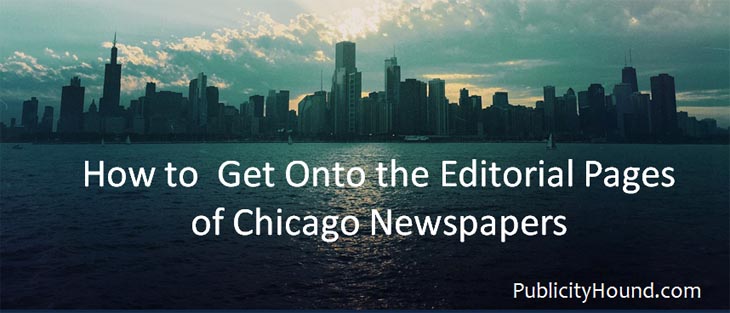
The slow death of daily newspapers means that over the last 30 years, the once almighty editorial pages have lost much of their influence as well as many of their readers.
Regardless, Publicity Hounds still look for every opportunity to use those opinion pages in a publicity campaign.
In Chicago, getting an op-ed in one of the two dailies, The Chicago Tribune or The Sun-Times, is still considered a major media kit. For business news, Crain’s Chicago Business competes with the business sections of the two dailies. And in the suburbs, The Daily Herald in Arlington Heights is the newspaper of choice for many subscribers.
Knowing the issues that are of greatest importance for each of those papers is key to promoting your cause or issue—and in some cases a product or service—on the editorial pages. Editors who set editorial policy for each of those four papers will appear during a luncheon panel called Demystifying Editorial Boards: A Conversation with the Agenda-Setters at Chicago’s Top Papers at the April 13 meeting of the Publicity Club of Chicago. It will be at Maggiano’s Restaurant, 516 N. Clark St.
Panelists include:
- Tom Corfman, assistant managing editor of Crain’s Chicago Business
- John McCormick, editorial page editor of The Chicago Tribune
- Tom McNamee, editorial page editor of The Chicago Sun-Times
- Jim Slusher, assistant managing editor/opinion page of The Daily Herald.
Registration is from 11:30 to noon, followed by the luncheon and program. See details here and register here.
How to Get the Editorial Board’s Attention
Can’t make it to the luncheon? As a member of the editorial boards of four newspapers where I worked for more than two decades, here’s my best advice on how to get in front of the editorial board of almost any newspaper.
-
Read the paper, do your research and know what they cover.
Yesterday, for example, I found an interview with Jim Kirk, publisher and editor-in-chief of The Chicago Sun-Times, on The Future of Print Media in Chicago. He says his paper wants to emphasize the local beats in which they have the strongest reporting—including watchdog reporting, politics, education, transportation and sports. You can be sure those topics are also at the top of the agenda for the editorial board.
-
Understand the difference between the editorial board and the reporting staff.
Reporters report the news. The editorial board—usually comprised of the editor, managing editor, editorial page editor and other top-level staff members—decides the position the newspaper will take in its editorials. So don’t blame the reporter if you don’t like an editorial. And don’t grouse that editorials don’t include the names of the journalists who wrote them. Newspaper columnists, who have their own opinions, are sometimes members of the editorial board.
- Be willing to meet with the editorial board for a getting-to-know-you session.
The more important your newsmaker or thought leader, the more interested the board will be in meeting with you. Don’t expect a story afterward, however.
Editorial boards I’ve served on met with people like new college presidents, new CEOs, or nonprofit executives who were preparing major fund-raising campaigns and wanted the newspaper’s support. Sometimes the board will ask you if it’s OK if the reporter covering that beat can also attend.
- If you’ll be announcing major news, a meeting “on background” with the editorial board a week or two before can help them understand important issues and perhaps gain their support.
“On background” usually means that they can use the information you give them, but they can’t name or quote you directly—at least not yet. As an editor, I found these sessions helpful because sources gave us background information about their news event that helped us better understand it and cover it.
Be careful, however, about off-the-record discussions which mean the media outlet can’t use the information in any way. Media trainer Brad Phillips says there are five rules of the road for going on background. Make absolutely sure you and the editorial board understand “the rules” you both will abide by.
-
Be willing to comment—and meet with them—when the news is bad.
Nothing is more galling than when a newsmaker who loves publicity runs for cover when the news turns sour and is suddenly unavailable for comment.
- Newspapers love to feature contrarian viewpoints on the editorial pages.
That includes opinion pieces that take the opposing viewpoint of the newspaper’s editorial board. Offer an opinion column, particularly if you have a viewpoint that few others are willing to share.
- Adhere to length limits in opinion columns and especially letters to the editor. Better for you to shorten your own opinion piece than have an editor do it for you and delete what you think is the most important part of the column. The major difference between an opinion column and a letter to the editor, by the way, is the length. Requirements for letters and opinion columns are usually printed somewhere on the editorial pages.
- Think multi-media.
Be ready to offer photos, infographics, video, audio or information in other formats for the newspaper’s print or online edition. If you’re offering a head shot, make sure it was taken recently. Some papers even interview newsmakers and offer the video at their websites.